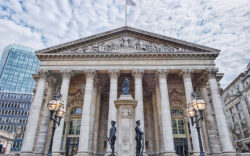- The geography of inflation gives clues as to its origin
- It is, ultimately, a monetary phenomenon
- It also makes investors’ lives complicated
“Winning isn’t everything. It’s the only thing.”
– Red Saunders, US football coach
Investing is about wealth generation or, at a minimum, preservation. There’s no other purpose for it.
That it seems so complicated to many has more to do with how poorly it is presented, quite deliberately, to obscure just how much investment institutions earn in fees. I’ve worked in the City. Believe me, I know.
It doesn’t help when governments and/or central banks run inflationary or, even worse, stagflationary economic policies. Merely preserving wealth in such an environment can be challenging indeed. And cash left idly in the bank isn’t just stagnant—it’s a guaranteed way to lose real purchasing power over time, rather than grow it.
It hasn’t always been that way.
Last week I took a few days off to visit Seville, capital of Andalusia and the fourth-largest city in Spain. It has a storied, almost legendary history of conquest, siege, plague, exploration, trade, innovation, architecture, art… just about everything that makes a city great.
One simple statistic helps to emphasise the point: more operas have been set in Seville than any other city: 153 to be precise.
One of the city’s landmarks is the Girolda tower, with a design incorporating Moorish, Romanesque, Gothic and Baroque features. I captured this shot on a sunny afternoon:
The advantages of position
All the above comes down to geography.
Seville is Spain’s only inland port, one that leads out into the Atlantic via the Guadalquivir River. The Romans founded a city there, Hispalis. Two emperors, Trajan and Hadrian, were born on estates nearby.
As with so many Roman cities in Western Europe, it would be sacked by the Vandals and Visigoths. Eventually the Moors of Spain would conquer the city along with most of Andalusia.
Moorish rule would last for centuries, although Vikings would successfully raid the city from time to time. As part of the Reconquista, Ferdinand III laid siege to the city for 15 months.
Seville has the dubious honour of hosting the first tribunal of the Inquisition in 1478. But not long thereafter, it became the focal point for the great voyages of discovery to the New World.
The Spanish galleons of the day were not only seaworthy for the Atlantic crossings; if skilfully handled they were able to navigate all the way up the Guadalquivir to the city, which was granted an official monopoly on all trade with the Americas.
As the goods arrived in ever greater variety and quantity, local industries grew to process, manufacture and distribute products that had not previously been available anywhere in Europe.
Among the most lucrative were tobacco and sugar. But as we know, the galleons also brought in a huge amount of silver and gold, both of which would be minted into coins at the Sevillana Casa de la Moneda.
The Sevillanos grew very rich indeed. But eventually they would become victims of their own success. With increased trade volumes and advances in shipbuilding, larger vessels were more economic to operate and safer.
By the 17th century the largest, most modern ships could no longer make their way upriver to the city and so the monopoly on trade was relocated to Cadiz. Seville would remain economically important but not dominant as before.
The city would also be hit hard by the plague in 1649, exacerbated by unusually high rainfall that caused the Guadalquivir to burst its banks. Seville lost half its population.
Live by geography, die by geography.
But the city had already made its mark on history. And it did so when gold and silver were actual money, absent the chronic money printing and inflation we are so accustomed to today. Cash held rather than lost value.
The Sevillian origins of inflation
Well, not quite. As it happens, in the 16th century there was so much silver and gold arriving in Seville, being minted into coinage and then spent into the economy, that prices began to rise.
First in Seville, then in surrounding towns, then eventually across all Spain and Europe, inflation flowed out of Seville, quite literally, in the form of freshly-minted gold and silver coins. Every time that flow of new coinage reached a new destination, prices would rise accordingly.
This was, at the time, a great curiosity. We take price inflation for granted today but in Renaissance Europe, price stability was the norm. Sure, many prices would rise or fall due to seasonal supply or demand factors. But a sustained, broad-based rise in prices didn’t begin until the influx of New World silver and gold started pouring into Seville—and then flowing outward.
The Spanish academics of the day, the Jesuits, set about investigating why prices just kept on rising, against all previous experience.
One of those scholars, Martín de Azpilcueta, eventually figured it out: as the supply of gold and silver rose, yet the supply of goods and services remained stable, prices had to rise to clear the market.
He and his colleagues at the Universidad de Salamanca are generally credited by modern economic historians as being the first to academically and systematically study trade and commerce.
Over two hundred years before Adam Smith published The Wealth of Nations.
And they were the first to discover how, as Milton Friedman put it, “Inflation is, always and everywhere, a monetary phenomenon.”
As we learned last week, the UK economy has slipped into recession yet again. Prices nevertheless continue to rise. Life for UK investors isn’t getting any easier.
Fortunately, savvy investors have real options to safeguard their wealth – and even turn stagflation into an opportunity. Discover how you can stay ahead of the curve right here.
Until next time,

John Butler,
Investment Director, Investor’s Daily
Good as Gold
Bill Bonner, writing from Baltimore, Maryland
The Golden Rule: He who has the gold makes the rules.
But gold doesn’t stay in one pocket forever. It moves. Then, someone else makes the rules.
In the news, Reuters:
Gold climbed to an all-time high on Thursday as the U.S. Federal Reserve signaled two possible interest rate cuts this year, adding to the precious metal’s appeal amid ongoing geopolitical and economic tensions. Spot gold added 0.1% to $3,050.94 an ounce as of 0520 GMT, after touching an all-time high of $3,057.21 earlier in the session.
Typically, a rising power accumulates gold. In the old days it did so by brute force. It conquered… and sent the booty back to its homeland. Or, it received tribute – in gold – from vassals. Or it extorted payment, in exchange for not attacking.
In the more modern version, political power comes from economic power. Dynamic economies sell more and more goods and services. For most of the 20th century, the US was the world’s leading manufacturer… its leading exporter… and its leading financial powerhouse.
These advantages were especially important during World Wars I and II. The allies relied on American industries to provide crucial goods. US producers took the orders, shipped the goods and (eventually) received payment in gold.
Up until 1971, trade imbalances were settled in gold. After 1971, all the seller would get for his excess dollars was more excess dollars, widely regarded ‘as good as gold.’
China is now the world’s leading manufacturer and exporter. For its trouble it ends up with a lot of dollars. Of course, it could trade those dollars for gold. But if it were to do so today, it would have to think twice. The gold price is over $3,000/oz.
It faces the same dilemma we all do: Buying gold is no longer a ‘no-brainer.’
And yet, gold is apparently still going up. MarketWatch:
Gold’s climb to an all-time high above $3,000 an ounce this week certainly turned heads, but its value is still around 16% below its inflation-adjusted record from 1980.
The price is up 39% over the last 12 months. And our Gold/Dow tells us it has a lot further to go. But there are no guarantees.
So far, gold fever has not reached individuals. Instead, it appears to be central banks that are stocking up. In the whirlwind ahead, gold may be the only thing they can hold onto.
The giant fraud of post-1971 dollars is that people can be made richer simply by printing up more of them. And it almost appears to be true. Add more dollars… things go up. Add them to Wall Street, asset prices go up – people feel richer. Add them to Main Street and consumer spending goes up… along with GDP and corporate profits.
It is only when the inflation reaches retail prices that the jig is up. And then, in the natural order of things, the pin finds its bubble and the whole edifice of inflated values comes crashing down (gold goes up… real values go down).
But in this case, the US introduced a sharp object of its own. It used its paper money system to force other nations into line. Glenn Diesen’s Substack:
BRICS Stockpiling Gold as the G7 Weaponised Finance
The West’s decision to freeze and legalise the theft of Russian sovereign funds predictably diminished trust in the Western financial system, resulting in a huge demand for gold and other precious metals as a safe haven. Gold is not a yield-bearing asset, yet it preserves its value during turbulent times. There are some more twists to the story: There is a rise in demand for physical gold and a push to store it in their home countries due to the lack of trust it can be stored safely in the West.
What was done to Russia could happen to anyone. An adversary like China is obviously next in line as the economic coercion to prevent its continued development intensifies. The EU demands China must pay a “higher cost” for supporting Russia, linking Russia and China seemingly for the purpose of convincing Trump to continue the war in Ukraine. Even friendly countries such as India could be targeted anytime with secondary sanctions for failing to bow to the demands of Washington.
China is having hundreds of tonnes of gold shipped from the West to China. Switzerland alone sent 524 tonnes of gold to China in 2022.India brought home 100 tonnes of gold from the UK in 2024, the first large shipment since 1991. The transfer and storage of these metals are neither convenient nor cheap, yet the collapse in trust demands drastic actions. Bloomberg reports on Singapore constructing a six-story warehouse “designed to hold 10,000 tons of silver, more than a third of global annual supply, and 500 tons of gold”.
How far this will go, we don’t know. Who will make the rules ten years from now? We don’t know that either.
So, we’ll hold onto our gold a while longer, and we’ll find out.
Regards,

Bill Bonner
Contributing Editor, Investor’s Daily
For more from Bill Bonner, visit www.bonnerprivateresearch.com





